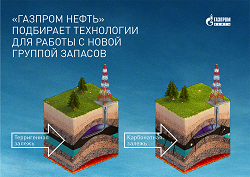- Home page /
- New technologies and equipment /
- Gazprom Neft continues its implementation of high-technology...
Gazprom Neft continues its implementation of high-technology drilling techniques
 |
| Courtesy of gazprom-neft.com |
Technology for drilling under draw-down pressure — allowing oil production during well construction — has been successfully utilised by Gazprom Neft — its application at the Gazpromneft-Vostok Archinskoye field having helped reveal a further 15 oil-bearing fissures — a seven-fold increase on traditional drilling methodologies. Production at this new well — at 160 tonnes of crude per day — is more than double the average output of similar wells, and fully covers the costs of involving a complex high-tech service.
Oil produced at Gazpromneft-Vostok’s fields comes from carbonate fractured reservoirs. Under these conditions, a well’s productivity depends on the number of natural cracks, which permeate this species of rock, opened during drilling. Under traditional drilling, the fluid pressure in the well is higher than that of the reservoir, so the drilling fluid flows into the fissures in the rock and partially blocks oil ingress into the well. In addition to this, when the solution is absorbed into the rock, it is impossible to continue drilling: the drilling fluid goes into a fissure, signals from geo-navigation equipment are lost, and the drill bit warms up. Which is why traditional drilling only allows one or two fissures to be opened at a time.
The issue of the absorption of drilling fluid has been resolved by “drilling under draw-down pressure”. The essence of this technology lies in the injection of drilling fluid at the same pressure as that of the formation or slightly lower, which avoids the fluid being absorbed. Ensuring the right pressure balance is a complex technological operation, implementation of which has involved mobilising equipment — with a total weight of more than 400 tonnes — in storage in Finland, the UAE and Iraq.
Drilling under draw-down pressure is more expensive than traditional drilling, but does have an additional advantage in allowing drilling to commence during well construction. Four hundred and fifty tonnes of oil have been obtained in drilling during work at the Archinskoye field, significantly increasing the efficiency of the operation. The equipment used in this technology means wells can be brought into operation within two days of drilling being completed — eight times faster than usual.
Once work is completed at the Archinskoye field, the technology will be tested on carbonate reservoirs at other Gazprom Neft assets: at Gazpromneft-Vostok, Gazpromneft-Orenburg, and in Eastern Siberia. Work with carbonate reservoirs is one of the nine key areas of Gazprom Neft’s Technology Strategy.
Vadim Yakovlev, First Deputy CEO, Gazprom Neft, commented: “Carbonate fissured reservoirs are complex reserves and, clearly, are going to constitute an increasing proportion of our portfolio. Which is why it is so important to find and test technological solutions that increase efficiency in working with these kinds of strata.”
Gazprom Neft has developed a programme for implementing new oil production technologies in carbonate and fractured reservoirs, — a category which includes more than 40 percent of the company’s recoverable reserves, or almost 600 million tonnes of hydrocarbons. The most significant assets containing such deposits include the eastern part of the Orenburg field, the Kuyumbinskoye and Chonsky fields in Eastern Siberia, the Badra project in Iraq, and the Prirazlomnoye field on the continental shelf of the Pechora Sea. In terms of global hydrocarbon reserves, carbonate reservoirs play an ever more significant role — the majority of new fields falling into precisely this category.
The features of carbonate reservoirs require high-level skills and competencies on the part of oil engineers, as well as the appropriate selection of technologies in order that development is as effective as possible. This new programme, developed by the Gazprom Neft Science and Technology Centre, comprises 12 technological initiatives in geological prospecting, field development, well boring, and oil production.
Source: gazprom-neft.com

